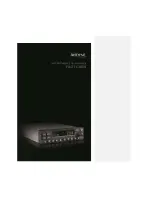
-2.15-
2.15 Factors Affecting ARPA Functions
Sea returns
If the radar anti-clutter control is adjusted properly, there is no serious effect because distant wave
clutter, not eliminated by this control, is filtered out by more than one bang correlation and
scan-to-scan matching of data.
Rain and snow
Clutter can be acquired and tracked as targets. Adjust the A/C RAIN control. If it is heavy rain,
switch to S-band if provided, or switch on the interference rejector on the radar. If heavy clutter still
exists, switch to manual acquisition. Accuracy can be affected.
Low clouds
Usually no effect. If necessary, adjust the A/C RAIN control.
Non-synchronous emissions
No effect.
Low gain
Insufficient or low radar receiver gain will result in some targets not being acquired at long distance.
ARPA display will be missing on one or more targets that could only be visible if the radar
sensitivity control (GAIN control) were increased.
The setting of the correct radar receiver gain is not critical but the target should be on the radar
display area and be clearly visible and well defined.
Manual acquisition is done if a target is positively displayed more than once. Automatic acquisition
is done when the target is detected 5-7 times continuously. Tracking is achieved when the target is
detected 5 times (not necessarily continuously) out of 10 scans. If not detected 6 times out of 10
scans, the target will become a "lost target." The ARPA or ATA will acquire a radar echo that is
present once in every six antenna scans and continue tracking if 1 in 10.
Second trace echoes
When the radar beam is super refracted, strong echoes may be received at such long ranges that
they appear on a different timebase sweep than the transmitted pulse. This gives an incorrect
range indication. Second and third trace echoes can be tracked if they are consistent enough to
meet acquisition and tracking criteria but target course and speed data will be in error.
Blind and shadow sectors
Radar shadow or blind areas caused by obstructions aboard ship, for example, funnels and masts,
in the path of the radar beam can result in reduction of radar beam intensity in that particular
direction. This may eliminate the detection of some targets. The ARPA or ATA system will lose
track of targets shortly after they are lost on the radar picture and if they remain in a blind zone.
These targets will however be acquired and tracked when they pass out of the blind zone and
again present normal radar echo. The angular width and bearing of any shadow sector should be
determined for their influence on the radar. In certain cases false echoes in the shadow sector
cause the ARPA or ATA system to acquire, track, and vector them. Shadow sectors should be
avoided.
Содержание FR-1500 MARK-3
Страница 1: ...15 MULTI COLOR HIGH PERFORMANCE SHIPBORNE RADAR AND ARPA FR 1500 MARK 3 SERIES Back ...
Страница 13: ...xi CONFIGURATION OF FR 1500 MARK 3 SERIES RADARS VIDEO PLOTTER RP 17 or RP 180 ...
Страница 14: ...xii This page is intentionally left blank ...
Страница 62: ...This page is intentionally left blank ...
Страница 86: ...This page is intentionally left blank ...
Страница 118: ... 9 6 FR 1500 MARK 3 series interfacing diagram CHANNEL 2 OUTPUT TTM ...
Страница 119: ... 9 7 ...
Страница 123: ......
Страница 124: ......
Страница 125: ......
















































